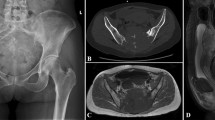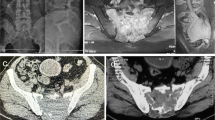Abstract
Background
Surgeries for primary malignancies involving upper sacrum require total en bloc sacrectomy followed by complex mechanical reconstruction, which might be simplified by application of the three-dimensional (3D) printing technique.
Purposes
To describe the design of a 3D-printed custom-made prosthesis for reconstruction after total en bloc sacrectomy, the surgical technique, and the clinical and functional outcome of a patient.
Methods
A 62-year-old patient with recurrent sacral chordoma was admitted in our center. One-stage total en bloc sacrectomy through posterior approach was planned, and a 3D-printed sacral prosthesis was prepared for reconstruction according to the anticipated osteotomic planes.
Results
The patient received one-stage total en bloc sacrectomy through posterior approach followed by reconstruction with the 3D-printed sacral prosthesis. The whole procedure took 5 h, and intra-operative blood loss was 3400 ml. The patient recovered uneventfully and started ambulation at 3 weeks after surgery. An asymptomatic instrument failure was found radiographically at 8-month follow-up. At 1 year after surgery, the patient was disease free and could walk over short distance with crutches without pain or any mechanical instability.
Conclusions
The advantages of our reconstruction method included: (1) the prosthesis provided an optimal reconstruction of lumbosacral and pelvic ring by integrating spinal pelvic fixation, posterior pelvic ring fixation, and anterior spinal column fixation in one step and (2) its porous surface could induce bone ingrowth and might enhance stability. Although there was an instrumental failure, we considered that it could be one reconstructive option. More research is warranted focusing on the modification of locations, diameters, and quantity of screws and biomechanical characteristics. The long-term functional and bone in-growth outcome will be followed to validate the use of the prosthesis.





Similar content being viewed by others
References
Sciubba DM, Petteys RJ, Garces-Ambrossi GL et al (2009) Diagnosis and management of sacral tumors. J Neurosurg Spine 10(3):244–256
Li D, Guo W, Tang X et al (2011) Surgical classification of different types of en bloc resection for primary malignant sacral tumors. Eur Spine J 20(12):2275–2281
Wuisman P, Lieshout O, Sugihara S et al (2000) Total sacrectomy and reconstruction: oncologic and functional outcome. Clin Orthop Relat Res 381:192–203
Bederman SS, Shah KN, Hassan JM et al (2014) Surgical techniques for spinopelvic reconstruction following total sacrectomy: a systematic review. Eur Spine J 23(2):305–319
Guo W, Tang X, Zang J et al (2013) One-stage total en bloc sacrectomy: a novel technique and report of 9 cases. Spine 38(10):E626–E631
Zang J, Guo W, Yang R et al (2015) Is total en bloc sacrectomy using a posterior-only approach feasible and safe for patients with malignant sacral tumors? J Neurosurg Spine 22(6):563–570
Gallia GL, Haque R, Garonzik I et al (2005) Spinal pelvic reconstruction after total sacrectomy for en bloc resection of a giant sacral chordoma. Technical note. J Neurosurg Spine 3(6):501–506
Gallia GL, Suk I, Witham TF et al (2010) Lumbopelvic reconstruction after combined L5 spondylectomy and total sacrectomy for en bloc resection of a malignant fibrous histiocytoma. Neurosurgery 67(2):E498–E502
Nishizawa K, Mori K, Saruhashi Y et al (2014) Long-term clinical outcome of sacral chondrosarcoma treated by total en bloc sacrectomy and reconstruction of lumbosacral and pelvic ring using intraoperative extracorporeal irradiated autologous tumor-bearing sacrum: a case report with 10 years follow-up. Spine J 14(5):e1–e8
Wuisman P, Lieshout O, van Dijk M et al (2001) Reconstruction after total en bloc sacrectomy for osteosarcoma using a custom-made prosthesis: a technical note. Spine 26(4):431–439
Newman CB, Keshavarzi S, Aryan HE (2009) En bloc sacrectomy and reconstruction: technique modification for pelvic fixation. Surg Neurol 72(6):752–756 (discussion 6)
Gokaslan ZL, Romsdahl MM, Kroll SS et al (1997) Total sacrectomy and Galveston L-rod reconstruction for malignant neoplasms. Technical note. J Neurosurg 87(5):781–787
Shah FA, Snis A, Matic A, Thomsen P, Palmquist A (2016) 3D printed Ti6Al4V implant surface promotes bone maturation and retains a higher density of less aged osteocytes at the bone-implant interface. Acta Biomater 30:357–367
Wong KC, Kumta SM, Geel NV et al (2015) One-step reconstruction with a 3D-printed, biomechanically evaluated custom implant after complex pelvic tumor resection. Comput Aided Surg 20(1):14–23
Xu N, Wei F, Liu X et al (2016) Reconstruction of the upper cervical spine using a personalized 3D-printed vertebral body in an adolescent with Ewing sarcoma. Spine 41(1):E50–E54
Tang X, Guo W, Yang R et al (2010) Use of aortic balloon occlusion to decrease blood loss during sacral tumor resection. J Bone Joint Surg Am 92(8):1747–1753
Allen BL Jr, Ferguson RL (1982) The Galveston technique for L rod instrumentation of the scoliotic spine. Spine 7(3):276–284
Zhang HY, Thongtrangan I, Balabhadra RS et al (2003) Surgical techniques for total sacrectomy and spinopelvic reconstruction. Neurosurg Focus 15(2):1–10
Lim SH, Jo DJ, Kim SM et al (2015) Reconstructive surgery using dual U-shaped rod instrumentation after posterior en bloc sacral hemiresection for metastatic tumor: case report. J Neurosurg Spine 23(5):630–634
Yu BS, Zhuang XM, Zheng ZM et al (2010) Biomechanical advantages of dual over single iliac screws in lumbo-iliac fixation construct. Eur Spine J 19(7):1121–1128
Mindea SA, Chinthakunta S, Moldavsky M et al (2012) Biomechanical comparison of spinopelvic reconstruction techniques in the setting of total sacrectomy. Spine 37(26):E1622–E1627
Spiegel DA, Richardson WJ, Scully SP et al (1999) Long-term survival following total sacrectomy with reconstruction for the treatment of primary osteosarcoma of the sacrum. A case report. J Bone Joint Surg Am 81(6):848–855
Dickey ID, Hugate RR Jr, Fuchs B et al (2005) Reconstruction after total sacrectomy: early experience with a new surgical technique. Clin Orthop Relat Res 438:42–50
Shen FH, Harper M, Foster WC et al (2006) A novel “four-rod technique” for lumbo-pelvic reconstruction: theory and technical considerations. Spine 31(12):1395–1401
Clark AJ, Tang JA, Leasure JM et al (2014) Gait-simulating fatigue loading analysis and sagittal alignment failure of spinal pelvic reconstruction after total sacrectomy: comparison of 3 techniques. J Neurosurg Spine 20(4):364–370
Le VH, Heckmann N, Jain N et al (2015) Biomechanical evaluation of supplemental percutaneous lumbo-sacro-iliac screws for spinopelvic fixation following total sacrectomy. J Spinal Disord Tech 28(4):E181–E185
Acknowledgements
No funds were received in support of this work. No benefits in any form have been or will be received from a commercial party related directly or indirectly to the subject of this manuscript.
Author information
Authors and Affiliations
Corresponding author
Ethics declarations
Conflict of interest
The authors declare that they have no conflict of interest.
Rights and permissions
About this article
Cite this article
Wei, R., Guo, W., Ji, T. et al. One-step reconstruction with a 3D-printed, custom-made prosthesis after total en bloc sacrectomy: a technical note. Eur Spine J 26, 1902–1909 (2017). https://doi.org/10.1007/s00586-016-4871-z
Received:
Revised:
Accepted:
Published:
Issue Date:
DOI: https://doi.org/10.1007/s00586-016-4871-z




